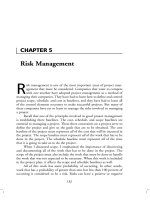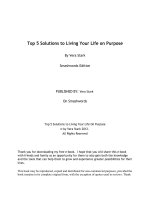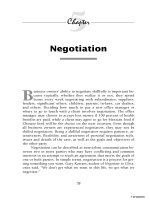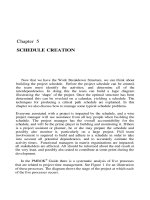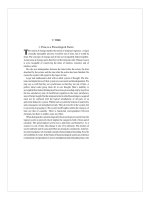Chapter 5 solutions excluding homework
Bạn đang xem bản rút gọn của tài liệu. Xem và tải ngay bản đầy đủ của tài liệu tại đây (272.57 KB, 41 trang )
Chapter 05 - Communicating and Interpreting Accounting Information
Chapter 5
Communicating and Interpreting
Accounting Information
ANSWERS TO QUESTIONS
1. The primary responsibility for the accuracy of the financial records and conformance
with Generally Accepted Accounting Principles (GAAP) of the information in the
financial statements rests with management, normally the CEO and CFO.
Independent auditors or CPAs are responsible for conducting an examination of the
statements in accordance with Generally Accepted Auditing Standards (for private
companies) and PCAOB Auditing Standards (for public companies), and based on
that examination, attesting to the fairness of the financial presentations in
accordance with GAAP. Both management and the auditors assume a financial
responsibility to users of the statements.
2. Financial analysts, who normally work for brokerage and investment banking
houses, mutual funds, and investment advisory services, gather extensive financial
and nonfinancial information about a company, on which they base forecasts and
stock purchase and sale recommendations. Private investors include individuals
who purchase shares in companies, often on the basis of recommendations from
financial analysts. Institutional investors are managers of pension, mutual,
endowment, and other funds that invest on behalf of others.
3. Information services provide a wide variety of financial and nonfinancial information
to analysts and investors, often on-line or on CD-ROM. These services are
normally the first source where important financial information such as quarterly
earnings announcements are available.
4. Material amounts are amounts that are large enough to influence a user’s decision.
5. a. Income statement--Accrual basis required by GAAP.
b. Balance sheet--Accrual basis required by GAAP.
c. Statement of cash flows--Cash basis required by GAAP.
6. Private companies normally issue quarterly and annual reports, both of which are
normally simple photocopied reports. The quarterly reports normally present
unaudited summary income statement and balance sheet information. The annual
reports include the four basic financial statements, related notes, and the auditor’s
opinion if the statements are audited.
Financial Accounting, 8/e 5- 1
© 2014 by McGraw-Hill Global Education Holdings, LLC. This is proprietary material solely for authorized instructor use. Not authorized for sale or distribution in
any manner. This document may not be copied, scanned, duplicated, forwarded, distributed, or posted on a website, in whole or part.
Chapter 05 - Communicating and Interpreting Accounting Information
7. Public companies issue quarterly press releases, quarterly reports, and annual
reports to shareholders and Forms 10-Q (quarterly reports), 10-K (annual reports),
and 8-K (special events) reports to the SEC. Press releases include a summary of
the quarterly report information and are the first announcement of quarterly financial
information. The quarterly reports normally present unaudited summary income
statement, cash flow statement, and balance sheet information along with
abbreviated management discussion and analysis and notes. Annual reports are
often elaborate reports including extensive discussions. The financial section
includes: (1) summarized financial data for a 5-year period; (2) management’s
discussion and analysis of financial condition and results of operations and
disclosures about market risk; (3) the four basic financial statements; (4) notes
(footnotes); (5) report of independent registered public accounting firm (auditor’s
opinion) and the management certification; (6) recent stock price information; (7)
summaries of the unaudited quarterly financial data; and (8) listings of directors
and officers of the company and relevant addresses. The Form 10-Q and 10-K
provide more detailed information than the quarterly and annual reports of private
companies including additional disclosures not included in those reports. The 8-K
is issued irregularly when special events, such as a change in auditors, occur.
8. The four major subtotals or totals on the income statement are: (a) gross profit, (b)
income from operations, (c) income before income taxes, and (d) net income.
9. The six major classifications on the balance sheet are: (a) current assets, (b)
noncurrent assets, (c) current liabilities, (d) long-term liabilities, (e) contributed
capital and (f) retained earnings.
10. Property, plant, and equipment are reported on the balance sheet. Property, plant,
and equipment are those assets held by the business not for resale but for use in
operating the business, such as a delivery truck. (a) Property, plant, and equipment
are reported at their acquisition cost which represents the amount of resources
expended in acquiring them. (b) Over their period of use, they are "depreciated"
because of being worn out (used up) or becoming obsolete in carrying out the
function for which they were acquired. A portion of the cost of this effect is known
as depreciation expense. A certain amount of depreciation is reported each period
as an expense on the income statement and the total amount of depreciation on the
asset from the date it was acquired up to the date of the financial statement is
known as accumulated depreciation. (c) Cost minus accumulated depreciation
equals net book value, as reported on the balance sheet. Net book value
(sometimes also called book value or carrying value) does not represent the current
market value of the asset but rather the original cost of it less the amount of that
cost that has been measured as depreciation expense for all of the periods since
the asset was acquired.
11. The major classifications of stockholders’ equity are: (1) contributed capital, which
represents the stockholders' investments and (2) retained earnings, which represent
the earnings of the company to date less any dividends paid to the owners.
5- 2 Solutions Manual
© 2014 by McGraw-Hill Global Education Holdings, LLC. This is proprietary material solely for authorized instructor use. Not authorized for sale or distribution in
any manner. This document may not be copied, scanned, duplicated, forwarded, distributed, or posted on a website, in whole or part.
Chapter 05 - Communicating and Interpreting Accounting Information
Contributed capital is often split between the account common stock (which consists
of a nominal legal amount called par value) and additional paid-in capital.
12. The three major classifications on the Statement of Cash Flows are (a) cash from
operating activities, (b) cash from investing activities, and (c) cash from financing
activities.
13. The three major categories of notes to the financial statements are: (1) descriptions
of accounting rules applied to the company’s statements, often called significant
accounting policies (e.g., the depreciation method applied to property, plant, and
equipment), (2) additional details about financial statement numbers (e.g., sales by
geographic region), and (3) relevant financial information not listed on the
statements (e.g., the existence of a bank line of credit).
14. Return on assets (ROA) is a ratio measure defined as net income divided by
average total assets. It measures how much the firm earned for each dollar of
assets available to management, regardless of the source of financing. A return on
assets analysis provides an overall framework for evaluating company performance
by breaking down ROA into its two determinants: net profit margin and total asset
turnover. Together, these indicate why ROA differs from prior levels or that of
competitors, and provide insights into strategies to improve ROA in future periods.
ANSWERS TO MULTIPLE CHOICE
1. b) 2. b) 3. c) 4. a) 5. b)
6. d) 10. a)
7. b) 8. c) 9. c)
Authors' Recommended Solution Time
(Time in minutes)
Alternate Cases and
Mini-exercises Exercises Problems Problems Projects
No. Time No. Time No. Time No. Time No. Time
1 5 1 10 1 30 1 40 1 30
2 5 2 10 2 20 2 20 2 30
3 5 3 15 3 40 3 40 3 40
4 10 4 10 4 20 4 35 4 30
5 10 5 20 5 20 5 30
6 10 6 30 6 40 6 30
7 10 7 15 7 35 7 40
8 20 8 40 8 *
9 25 9 20
10 25
11 25 Continuing Cases
12 12 1 45
13 15 2 45
14 15
Financial Accounting, 8/e 5- 3
© 2014 by McGraw-Hill Global Education Holdings, LLC. This is proprietary material solely for authorized instructor use. Not authorized for sale or distribution in
any manner. This document may not be copied, scanned, duplicated, forwarded, distributed, or posted on a website, in whole or part.
Chapter 05 - Communicating and Interpreting Accounting Information
15 15
16 20
17 25
18 20
19 20
* Due to the nature of these cases and projects, it is very difficult to estimate the amount
of time students will need to complete the assignment. As with any open-ended project,
it is possible for students to devote a large amount of time to these assignments. While
students often benefit from the extra effort, we find that some become frustrated by the
perceived difficulty of the task. You can reduce student frustration and anxiety by
making your expectations clear. For example, when our goal is to sharpen research
skills, we devote class time discussing research strategies. When we want the students
to focus on a real accounting issue, we offer suggestions about possible companies or
industries.
5- 4 Solutions Manual
© 2014 by McGraw-Hill Global Education Holdings, LLC. This is proprietary material solely for authorized instructor use. Not authorized for sale or distribution in
any manner. This document may not be copied, scanned, duplicated, forwarded, distributed, or posted on a website, in whole or part.
Chapter 05 - Communicating and Interpreting Accounting Information
MINI-EXERCISES
M5-1.
Players Definitions
____D____ (1) Independent auditor A. Adviser who analyzes financial and other economic
____C____ (2) CEO and CFO information to form forecasts and stock recommendations.
____B____ (3) Users
____A____ (4) Financial analyst B. Institutional and private investors and creditors (among
others).
C. Chief executive officer and chief financial officer who have
primary responsibility for the information presented in financial
statements.
D. Independent CPA who examines financial statements and
attests to their fairness.
M5-2.
No. Title
____3_____ Form 10-K
____1_____ Earnings press release
____2_____ Annual report
Note: Many companies now issue the annual report and the 10-K at the same time.
M5-3. Elements of Financial Statements
Financial Statements
A A. Income statement
C (1) Expenses B. Balance sheet
A (2) Cash from operating activities C. Cash flow statement
B (3) Losses D. None of the above
A (4) Assets
C (5) Revenues stockholder
A (6) Cash from financing activities
B (7) Gains
B (8) Owners' equity
D (9) Liabilities
(10) Assets personally owned by a
Financial Accounting, 8/e 5- 5
© 2014 by McGraw-Hill Global Education Holdings, LLC. This is proprietary material solely for authorized instructor use. Not authorized for sale or distribution in
any manner. This document may not be copied, scanned, duplicated, forwarded, distributed, or posted on a website, in whole or part.
Chapter 05 - Communicating and Interpreting Accounting Information
M5-4.
Transaction Current Gross Profit Current
Assets Liabilities
a. +
b. + NE NE
NE +
The effects of the transactions can be seen by making the related journal entries and
using CA, CL, R, and E to denote current asset, current liability, revenue, and expense,
respectively.
a. Accounts receivable (+CA) .......................................... 300
Sales revenue (+R)............................................ 300
Cost of goods sold (+E)................................................. 200
Inventory (–CA) ................................................ 200
Note that Gross Profit increases (by $100) since it is defined as Sales (increased
by $300) less Cost of Goods Sold (increased by only $200).
b. Advertising expense (+E) ............................................ 10
Accounts payable (+CL) ................................... 10
Note that Advertising Expense is not included in Cost of Goods Sold and, hence,
has no effect on Gross Profit.
M5-5.
Assets Liabilities Stockholders’ Equity
Sales Revenue +1,800
a.) Accounts Receivable +1,800 Cost of Goods Sold-1,200
Inventory -1,200
b.) Cash +60,000 *Common stock +5,000
**Additional paid-in
capital +55,000
*$1 par value 5,000 shares
**$60,000 cash - $5,000 common stock
5- 6 Solutions Manual
© 2014 by McGraw-Hill Global Education Holdings, LLC. This is proprietary material solely for authorized instructor use. Not authorized for sale or distribution in
any manner. This document may not be copied, scanned, duplicated, forwarded, distributed, or posted on a website, in whole or part.
Chapter 05 - Communicating and Interpreting Accounting Information 1,800 1,800
1,200 1,200
M5-6.
60,000
a. Accounts receivable (+A) ..........................................................
Sales revenue (+R, +SE) ............................................... 5,000
55,000
Cost of goods sold (+E, –SE) ...................................................
Inventory (–A) ................................................................
b. Cash (+A)...................................................................................
Common stock ($1 par value 5,000 shares) (+SE)....
Additional paid-in capital (+SE)......................................
($60,000 cash - $5,000 common stock)
M5-7.
Return on assets (ROA) = Net income = $100 = $100 = 0.111 (11.1%)
Avg total assets ($1,000+$800)/2 $900
Return on assets (ROA) measures how much the firm earned for each dollar of
investment.
Financial Accounting, 8/e 5- 7
© 2014 by McGraw-Hill Global Education Holdings, LLC. This is proprietary material solely for authorized instructor use. Not authorized for sale or distribution in
any manner. This document may not be copied, scanned, duplicated, forwarded, distributed, or posted on a website, in whole or part.
Chapter 05 - Communicating and Interpreting Accounting Information
EXERCISES Definitions
E5-1. A. Financial institution or supplier that lends money to the
company.
Players
B. Chief Executive Officer and Chief Financial Officer who
F (1) Financial have primary responsibility for the information
analyst presented in financial statements.
A (2) Creditor C. Manager of pension, mutual, and endowment funds
H (3) Independent that invest on the behalf of others.
auditor D. Securities and Exchange Commission which regulates
G (4) Private financial disclosure requirements.
investor E. A company that gathers, combines, and transmits
D (5) SEC (paper and electronic) financial and related information
E (6) Information from various sources.
service F. Adviser who analyzes financial and other economic
C (7) Institutional information to form forecasts and stock
recommendations.
investor
B (8) CEO and G. Individual who purchases shares in companies.
H. Independent CPA who examines financial statements
CFO
and attests to their fairness.
E5-2. Definitions
A. Report of special events (e.g., auditor changes,
Information Release
C (1) Form 10-Q mergers) filed by public companies with the
B (2) Quarterly report SEC.
D (3) Press release B. Brief unaudited report for quarter normally
F (4) Annual report containing summary income statement and
E (5) Form 10-K balance sheet.
A (6) Form 8-K C. Quarterly report filed by public companies with
the SEC that contains additional unaudited
financial information.
D. Written public news announcement that is
normally distributed to major news services.
E. Annual report filed by public companies with the
SEC that contains additional detailed financial
information.
F. Report containing the four basic financial
statements for the year, related notes, and
often statements by management and auditors.
5- 8 Solutions Manual
© 2014 by McGraw-Hill Global Education Holdings, LLC. This is proprietary material solely for authorized instructor use. Not authorized for sale or distribution in
any manner. This document may not be copied, scanned, duplicated, forwarded, distributed, or posted on a website, in whole or part.
Chapter 05 - Communicating and Interpreting Accounting Information
E5-3.
Information Item Report
B,F (1) Summarized financial data for 5-year period. A. Form 10-Q
B,F (2) Notes to financial statements. B. Annual report
B,F (3) The four basic financial statements for the year. C. Form 8-K
E (4) Summarized income statement information for the D. Press release
quarter. E. Quarterly report
F (5) Detailed discussion of the company’s competition. F. Form 10-K
D (6) Initial announcement of hiring of new vice president G. None of the above
for sales.
D (7) Initial announcement of quarterly earnings.
B,F (8) A description of those responsible for the financial
statements.
A (9) Complete quarterly income statement, balance sheet
and cash flow statement.
C (10) Announcement of a change in auditors.
E5-4.
No. Title
7 Long-term liabilities
6 Current liabilities
2 Long-term investments
4 Intangible assets
8 Contributed capital
1 Current assets
9 Retained earnings
3 Property, plant, and equipment
5 Other noncurrent assets
Financial Accounting, 8/e 5- 9
© 2014 by McGraw-Hill Global Education Holdings, LLC. This is proprietary material solely for authorized instructor use. Not authorized for sale or distribution in
any manner. This document may not be copied, scanned, duplicated, forwarded, distributed, or posted on a website, in whole or part.
Chapter 05 - Communicating and Interpreting Accounting Information $ 484
560
E5-5. 767
152
Campbell Soup Company
Consolidated Balance Sheet 1,963
2,103
July 31, Current Year 2,660
(in millions)
136
Assets $6,862
Current Assets
$ 585
Cash and cash equivalents 619
Accounts receivable 785
Inventories
Other current assets 1,989
3,777
Total current assets 5,766
Property, plant, and equipment, net
Intangible assets 351
Other assets 745
1,096
Total assets $6,862
Liabilities and Stockholders' Equity
Current liabilities
Accounts payable
Accrued expenses
Other current debt
Total current liabilities
Other noncurrent liabilities
Total liabilities
Stockholders' Equity
Common stock, $0.0375 par value
Retained earnings
Total stockholders' equity
Total liabilities and stockholders' equity
5- 10 Solutions Manual
© 2014 by McGraw-Hill Global Education Holdings, LLC. This is proprietary material solely for authorized instructor use. Not authorized for sale or distribution in
any manner. This document may not be copied, scanned, duplicated, forwarded, distributed, or posted on a website, in whole or part.
Chapter 05 - Communicating and Interpreting Accounting Information $ 20,841
143,238
E5-6. 106,261
20,705
Req. 1. 96,983
388,028
Snyder’s-Lance 313,043
Consolidated Balance Sheet 367,853
December 31, Current Year 376,062
21,804
(in millions)
$1,466,790
Assets
Current Assets $ 52,930
Cash and cash equivalents 29,248
Accounts receivable, net 68,712
Inventories 4,256
Prepaid expenses and other
Other current assets 155,146
253,939
Total current assets 219,114
Property, plant and equipment, net 628,199
Goodwill
Other intangible assets, net 56,515
Other assets 730,338
Total assets
Liabilities and Stockholders’ Equity 51,738
838,591
Current Liabilities $1,466,790
Accounts payable
Accrued compensation
Other payables and accrued liabilities
Short-term debt
Total current liabilities
Long-term debt
Other long-term liabilities
Total liabilities
Stockholders' Equity
Common stock, 67,820,798 shares outstanding
Additional paid-in capital
Retained earnings
Total stockholders' equity
Total liabilities and stockholders' equity
Financial Accounting, 8/e 5- 11
© 2014 by McGraw-Hill Global Education Holdings, LLC. This is proprietary material solely for authorized instructor use. Not authorized for sale or distribution in
any manner. This document may not be copied, scanned, duplicated, forwarded, distributed, or posted on a website, in whole or part.
Chapter 05 - Communicating and Interpreting Accounting Information
E5-6. (continued)
Req. 2.
In each case, the term “net” means that the account is reported after the balance in the
related contra account has been subtracted. Accounts receivable, net means that the
allowance for doubtful accounts contra account has been subtracted. Other intangible
assets, net means that the accumulated amortization contra account has been
subtracted. Property, plant and equipment, net means that the accumulated
depreciation contra account has been subtracted.
5- 12 Solutions Manual
© 2014 by McGraw-Hill Global Education Holdings, LLC. This is proprietary material solely for authorized instructor use. Not authorized for sale or distribution in
any manner. This document may not be copied, scanned, duplicated, forwarded, distributed, or posted on a website, in whole or part.
Chapter 05 - Communicating and Interpreting Accounting Information
E5-8.
TOWNSHIP CORPORATION
Income Statement
For the Year Ended December 31, 2015
Sales revenue.................................. Computations in Order $7,000 $85,000
Cost of goods sold...........................(a) Given 10 ,000 55 ,000
Gross profit...................................... $85,000 - $30,000 30,000
Operating expenses: Given
17 ,000
Selling expense............................. Given 13,000
Administrative expense.................(c) $17,000 – $7,000
Total operating expenses................(b) $30,000 – $13,000 4,550
Pretax income.................................. Given $ 8,450
$13,000 x 35%*
Income tax expense....................(d) $13,000 – $4,550
Net income......................................(e)
Earnings per share ($8,450 2,500 shares*) $3.38
*Given
Gross profit percentage = Gross profit = 30,000 = 0.353 (35.3%)
Net sales 85,000
Financial Accounting, 8/e 5- 13
© 2014 by McGraw-Hill Global Education Holdings, LLC. This is proprietary material solely for authorized instructor use. Not authorized for sale or distribution in
any manner. This document may not be copied, scanned, duplicated, forwarded, distributed, or posted on a website, in whole or part.
Chapter 05 - Communicating and Interpreting Accounting Information
E5-9.
Req. 1.
Hewlett Packard Company
Consolidated Statement of Income
For Year Ended October, Current Year
(In millions)
Net sales assets $84,799 $126,033
Product sales 40,816
Service sales 418 0
Financing income 30,077
65,064
Total net revenue 30,590 0
Cost of sales: 11,479
302
Cost of products 505
Cost of services 2,959 10,974
Cost of financing 12,718
2,213
Total cost of sales 1,484 8,761
Gross profit 1,144 $3.78
Operating expenses: 2,319
293
Research and development
Selling, general and administrative
Amortization of purchased intangible
Restructuring charges
Acquisition-related charges
Total operating expenses
Operating income
Interest expense
Income before income taxes
Provision for taxes
Net income
Net earnings per share
Weighted average shares outstanding
Req. 2.
Product sales: $84,799 – $65,064 = $19,735
5- 14 Solutions Manual
© 2014 by McGraw-Hill Global Education Holdings, LLC. This is proprietary material solely for authorized instructor use. Not authorized for sale or distribution in
any manner. This document may not be copied, scanned, duplicated, forwarded, distributed, or posted on a website, in whole or part.
Chapter 05 - Communicating and Interpreting Accounting Information
E5-10.
Case A Case B Case C Case D Case E
$600 $500
Sales revenue $800 $1,170* $760*
150 280*
Cost of goods sold 425* 450* 220* 500 320
Gross margin 375 50 80 670* 440
100* 70
Operating expenses: 150* 150*
300 70*
Selling expense 50* 20 350 240
30 $50 120 80
Administrative expense 125 $270* 470*
200 320*
Total expenses 175* 120*
50
Pretax income 200 $150* 20
$100
Income tax expense 50*
Net income $150
*Amounts not given in the exercise.
E5-11.
Case A Case B Case C Case D Case E
$600 $1,050
Sales revenue $770 $1,200* $400*
250 420 *
Cost of goods sold 300* 320 125 350* 630
Gross margin 470* 880 275* 70 85*
150 * 175
Operating expenses: 220* 260*
130 370
Selling expense 90 275 45 130 *
120 80 45 $240
Administrative expense 200 395* 125* $85*
485* 150
Total expenses 290* 210 60
$275 $90 *
Pretax income 180*
Income tax expense 65
Net income $115
*Amounts not given in the exercise.
E5-12.
Common Stock Additional Retained Total
Shares Amount Paid-in Earnings Stockholders'
Capital
Shares issued for 12,100 121 Equity
employee stock option 343,879
plan 344,000
Financial Accounting, 8/e 5- 15
© 2014 by McGraw-Hill Global Education Holdings, LLC. This is proprietary material solely for authorized instructor use. Not authorized for sale or distribution in
any manner. This document may not be copied, scanned, duplicated, forwarded, distributed, or posted on a website, in whole or part.
Chapter 05 - Communicating and Interpreting Accounting Information
E5-14.
Transaction Current Gross Profit Current
Assets Liabilities
a. +$2,449.3 +$2,449.3
b. +$500.0 NE NE
c. –$197.6 NE +$500.0
NE
The effects of the transactions can be seen by making the related journal entries and
using CA, CL, R, and E to denote current asset, current liability, revenue, and expense,
respectively.
a. Accounts receivable (+CA) .......................................... 4,285.6
Sales revenue (+R)............................................ 4,285.6
Cost of goods sold (+E)................................................. 1,836.3
Inventory (–CA) ................................................ 1,836.3
Note that Gross Profit increases (by $2,449.3) since it is defined as Sales
(increased by $4,285.6) less Cost of Goods Sold (increased by only $1,836.3).
b. Cash (+CA) .................................................................. 500.0 500.0
Notes payable (+CL) ........................................
c. Research and development expense (+E) .................. 197.6
Cash (–CA) ....................................................... 197.6
Note that Research and Development Expense is not included in Cost of Goods
Sold and, hence, has no effect on Gross Profit.
5- 16 Solutions Manual
© 2014 by McGraw-Hill Global Education Holdings, LLC. This is proprietary material solely for authorized instructor use. Not authorized for sale or distribution in
any manner. This document may not be copied, scanned, duplicated, forwarded, distributed, or posted on a website, in whole or part.
Chapter 05 - Communicating and Interpreting Accounting Information
E5-15.
Transaction Current Gross Profit Current Cash Flow from
Assets Liabilities Operating Activities
a. NE
b. NE NE NE + 40.8
– 5.6 – 5.6 NE
The effects of the transactions can be seen by making the related journal entries and
using CA and CL to denote current asset and current liability, respectively.
a. Cash (+CA).................................................................... 40.8
Accounts receivable (–CA)................................. 40.8
b. Notes payable (–CL)..................................................... 5.6
Cash (–CA)......................................................... 5.6
Note that repayment of debt is a financing activity.
E5-16. $25,000
(9,000)
AVALOS CORPORATION 1,000
Statement of Cash Flows (3 ,000)
For the Year Ended December 31, 2014
$ 14,000
From Operating Activities
Net income .................................................................. (7,000)
Increase in accounts receivable .................................. (36 ,000)
Decrease in inventory ..................................................
Decrease in accounts payable .................................... (43,000)
Cash flows from operating activities........................
30,000
From Investing Activities 24 ,000
Purchased a new delivery truck...................................
Purchased land............................................................ 54 ,000
Cash flows from investing activities......................... 25,000
25 ,000
From Financing Activities $ 50,000
Borrowed cash on three-year note...............................
Issued stock for cash....................................................
Cash flows from financing activities.........................
Net cash inflows for the year...............................
Beginning cash balance......................................................
Ending cash balance..........................................................
Financial Accounting, 8/e 5- 17
© 2014 by McGraw-Hill Global Education Holdings, LLC. This is proprietary material solely for authorized instructor use. Not authorized for sale or distribution in
any manner. This document may not be copied, scanned, duplicated, forwarded, distributed, or posted on a website, in whole or part.
Chapter 05 - Communicating and Interpreting Accounting Information
E5-17.
Req. 1.
Net Income (given) Current Prior
Average Total Assets Year Year
(given)
$439,190 = 0.111 $368,403 = 0.102
$3,947,331 $3,612,015
The increase in ROA from 0.102 in the prior year to 0.111 in the current year means
that the firm earned $0.009 more for each $1 of investment.
Req. 2. Current Prior
Year Year
ROA Analysis $368,403 = 0.1194
Net Income $439,190 = 0.1206 $3,085,290
Net Sales $3,642,937
x Net Sales $3,085,290 = 0.8542
Average Total Assets $3,642,937 = 0.9229 $3,612,015
$3,947,331
Return on Assets
0.111 0.102
The increase in ROA is caused by increases in both net profit margin and asset
turnover (from 0.119 to 0.121 and from 0.854 to 0.923, respectively). The company’s
profit margin and efficiency appear to have increased with the economic recovery.
5- 18 Solutions Manual
© 2014 by McGraw-Hill Global Education Holdings, LLC. This is proprietary material solely for authorized instructor use. Not authorized for sale or distribution in
any manner. This document may not be copied, scanned, duplicated, forwarded, distributed, or posted on a website, in whole or part.
Chapter 05 - Communicating and Interpreting Accounting Information
E5-18.
Req. 1.
Current Prior
Year Year
Net Income (given) $59,387 = 0.147 $55,425 = 0.141
Average Total Assets
(given) $403,162 $394,143
The increase in ROA from 0.141 in the prior year to 0.147 in the current year means
that the firm earned $0.006 more for each $1 of investment.
Req. 2.
Security analysts would be more likely to increase their estimates of share value on the
basis of this change. The company increased its earnings by $0.006 for each $1 of
investment and, hence, increased the corresponding value of that investment.
Financial Accounting, 8/e 5- 19
© 2014 by McGraw-Hill Global Education Holdings, LLC. This is proprietary material solely for authorized instructor use. Not authorized for sale or distribution in
any manner. This document may not be copied, scanned, duplicated, forwarded, distributed, or posted on a website, in whole or part.
Chapter 05 - Communicating and Interpreting Accounting Information
PROBLEMS
P5-1.
(1) E; (2) L; (3) D; (4) I; (5) M; (6) W; (7) B; (8) Q; (9) A; (10) H; (11) U; (12) J; (13) C;
(14) G; (15) V; (16) R; (17) K; (18) N; (19) T; (20) S; (21) O; (22) P; (23) F.
P5-2.
P (1) Capital in excess of par B (11) Current liabilities
E (2) Assets C (12) Long-term liabilities
M (3) Retained earnings N (13) Fixed assets
O (4) Book value F (14) Liabilities
J (5) Other assets L (15) Contra-asset account
I (6) Shares outstanding K (16) Accumulated depreciation
D (7) Shareholders’ equity H (17) Intangible assets
A (8) Liquidity
Q (9) Normal operating cycle
G (10) Current assets
5- 20 Solutions Manual
© 2014 by McGraw-Hill Global Education Holdings, LLC. This is proprietary material solely for authorized instructor use. Not authorized for sale or distribution in
any manner. This document may not be copied, scanned, duplicated, forwarded, distributed, or posted on a website, in whole or part.

